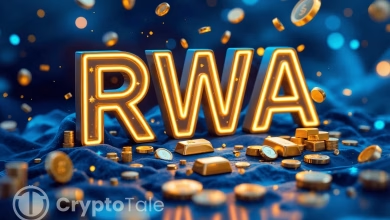How Blockchain Is Transforming Finance, Identity, and Supply Chains?

Blockchain technology, the backbone of cryptocurrency, has expanded beyond digital money and payments. Its ability to offer secure, transparent, and tamper-proof records is transforming industries, including healthcare, supply chains, identity systems, and even government operations.
Blockchain and Decentralization
Blockchain is a distributed ledger technology that keeps a record of transactions across several computers. The records, known as blocks, are connected via a hash, thus making them transparent and tamper-proof. Decentralized control is implemented on multiple nodes rather than just on a single server or organization.
As U.S. Representative Kat Cammack noted, “Blockchain is more than cryptocurrency. It’s next-generation infrastructure that can transform how we secure our supply chains and protect sensitive data.”
Moreover, with the usage of smart contracts, rules can be automated without central intermediaries, which supports new applications in areas such as public services, industry, and digital assets.
Stablecoins
Pegged to the US Dollar, stablecoins became the basis of a multitrillion-dollar market worldwide. In 2024 alone, the volume of transactions in stablecoins increased to over $5 trillion. By August 2025, the market cap hit $280 billion, marking an all-time high.
In addition, their adoption and use cases have been showcased in governments. Wyoming became the first U.S. state to tokenize state-held U.S. dollars with the Frontier Stable Token (FRNT), a state-issued stablecoin fully backed 1:1 by cash reserves.
Furthermore, FRNT’s multi-chain launch on blockchains like Ethereum, Solana, Polygon, Base, Avalanche, Arbitrum, and Optimism showcases blockchain interoperability, keeping one consistent value across diverse networks. By converting dollars into on-chain tokens, FRNT enables fast, low-cost transfers and programmable finance without intermediaries.
Related: Blockchain Will Lead the Future: Franklin Templeton CEO
Government and Public Services
Moving past stablecoins (issued mainly by private entities) to government-issued digital currencies, central Bank Digital Currencies (CBDCs) are the formal adoption of blockchain-inspired technology by monetary authorities. A CBDC is simply a digital version of a nation’s fiat currency, issued and regulated by the central bank, and it possesses a fixed value equivalent to the national currency.
Unlike decentralized cryptocurrencies, CBDCs are centralized in terms of issuance, but they often use distributed ledger technology for resilience and security. As of 2025, several countries have issued or tested CBDCs. The Chinese digital yuan, Nigerian eNaira, and Sand Dollar in the Bahamas are already circulating, and more than 100 central banks are running pilots.
In addition, governments have proposed to use blockchain for transparency and record-keeping. The U.S. Commerce Department now posts official GDP and inflation statistics on multiple blockchains via Chainlink oracles, providing an immutable public data source.
Estonia’s government, a blockchain pioneer, uses a KSI distributed ledger to protect critical citizen data (from healthcare to justice). With KSI, data authenticity is “mathematically proven,” and history cannot be rewritten even by insiders.
Blockchain is also becoming central to major digital identity projects. The UN described a global Digital ID framework in 2024, and the EU required the use of blockchain-based national ID wallets by 2026. These initiatives depict how the security and transparency offered by blockchain are transforming public finance, data, and citizen services.
Decentralized Finance
Decentralized Finance (DeFi) is a category of blockchain-powered financial applications that do not rely on any traditional bank or middleman. Furthermore, DeFi users can lend, borrow, trade, and invest crypto-assets directly in a peer-to-peer network via smart contracts.
As of 2025, DeFi had grown into a strong ecosystem, and its value had increased. The main benefits of DeFi are 24/7 accessibility, universality, and financial product innovation. Examples are onchain platforms such as Uniswap, which facilitate peer-to-peer token swaps, and lending platforms such as Aave and MakerDAO, which provide bankless loans.
Major tech and fintech firms are also building specialized blockchains for financial use. Google Cloud unveiled its Universal Ledger (GCUL), a permissioned Layer-1 blockchain for banks with built-in compliance and Python-based smart contracts.
Digital Identity and Privacy
Blockchain’s cryptography has unlocked new approaches to digital identity and privacy. Decentralized identity systems (DID) let individuals control their own digital credentials, rather than depend on centralized authorities. Governments and standards bodies are embracing this shift as initiatives like EU’s eIDAS 2.0 and UN Digital ID programs plan interoperable blockchain-backed identity wallets by mid-decade.
At the same time, blockchain-based privacy techniques are maturing. Zero-knowledge proofs (ZKPs) allow one party to prove a statement true without revealing underlying data. Privacy coins (e.g., Zcash) and scalability solutions known as ZK-rollups are built on ZKPs. In a ZK-rollup, thousands of transactions are aggregated off-chain, and a single cryptographic evidence is published on-chain.
This validates all transactions without exposing user details, dramatically cutting gas costs while preserving confidentiality. For example, Ethereum rollups like zkSync and StarkNet rely on ZKPs to increase throughput. These privacy-preserving methods make blockchain services – from medical record access to digital IDs – more secure by design.
Supply Chain Traceability: Transparency and Trust in Logistics
Global supply chains include numerous parties and complicated logistics, which are prone to a lack of transparency and fraud. Blockchain combats this by documenting each stage, which goes through an immutable ledger, making an end-to-end supply chain traceability system.
Several industries use blockchain for supply chain transparency and product provenance. Retailers can trace items in seconds: Walmart’s blockchain pilots slashed produce traceback time from days to seconds. In one test, tracing a carton of mangoes took 6 days via traditional systems but only 2 seconds on-chain.
By 2018, Walmart and partners extended this program (with IBM’s Food Trust) to dozens of foods (leafy greens, pork, etc.), requiring suppliers to record each step from farm to shelf.
Apart from that, De Beers tracks every high-value diamond from mine to retail on a shared ledger, ensuring conflict-free provenance while shipping giants like Maersk’s TradeLens (with IBM) use blockchains to monitor cargo containers in real time.
The blockchain-based immutable ledger and distributed consensus can be applied to develop a shared, verifiable record between multiple parties, significantly enhancing traceability and reliability throughout the global supply network.
Scalable Infrastructure and Interoperability
For blockchain to power mass-market services, networks must scale and interoperate. Layer-1 blockchains (Bitcoin, Ethereum, Solana, etc.) provide the base ledger, using consensus mechanisms (originally proof-of-work, now mostly proof-of-stake) for security.
Layer-2 scaling solutions, including optimistic rollups or ZK-rollups, run off-chain transactions. An example is a ZK-rollup that batches user transactions off-chain and posts a single proof to Ethereum, which reduces fees and improves speed. This method maintains Ethereum’s security and supports thousands of transactions a second.
Underlying these uses is blockchain interoperability. Since most blockchains are isolated, protocols such as Cosmos IBC and Polkadot enable cross-chain transfers. Wyoming’s FRNT stablecoin illustrates this in practice, operating seamlessly on multiple blockchains while keeping one unified value. With interoperability, tokenized assets and NFTs can freely flow across networks, creating a connected blockchain economy.
Tokenized Assets and Digital Collectibles
Non-Fungible Tokens (NFTs) serve as digital certificates of ownership or authenticity recorded on a blockchain. They became famous in 2021 for representing digital art and collectibles, but their use expanded in 2025. NFTs are used for things like event tickets, music rights, virtual land in metaverse platforms, and even identification credentials.
In addition to NFTs, the tokenization of real-world assets is increasing. A range of financial instruments, such as stocks, funds, and bonds, are being tokenized to trade more efficiently. Tokens can also be digitized versions of any asset (securities, real estate, commodities, carbon credits) and can be easily settled instantly and traded anytime as markets operate 24/7.
Some platforms today trade shares or property units as blockchain tokens, merging traditional markets with onchain efficiency.
In an earlier incident, when Circle launched Arc, an open Layer-1 chain purpose-built for stablecoin finance, Arc used USDC as native gas, included an onchain FX engine, and achieved sub-second finality. Circle’s Arc explicitly cites support for “tokenized equities, commodities, and real estate,” meaning stocks, commodities, or real estate can be issued and settled on-chain as easily as tokens.
Moreover, in July 2025, it was reported that large banks have started expressing increasingly greater interest in tokenizing assets to enable faster and less expensive trading. Projects are underway to allow the execution of tokenized shares of companies or tokenized commodities over blockchain platforms.
These tokenization models are changing the way value is issued and traded: rare assets gain liquidity and transparency, and creators and owners can experiment with creative monetization models (such as perpetual royalties or onchain governance rights).
Related: Circle Unveils ARC Blockchain, Reports 53% Revenue Increase
Decentralized Autonomous Organization (DAOs)
According to one definition, “A DAO is an organizational structure with no central governing body. It is run by code on the blockchain rather than a hierarchical leadership system.”
Blockchain also changes organizational models. Decentralized Autonomous Organizations (DAOs) operate using smart contracts and token voting, giving communities control over governance resources without a central authority.
In a DAO, members hold tokens that give voting power on proposals, and outcomes are enforced automatically by code. Examples like Aragon and DAOstack provide frameworks for such structures.
DAOs are now custodians of multi-million-dollar treasuries, and a prime example would be the MakerDAO community, which operates a leading crypto lending protocol, with parameters determined by transparent onchain votes.
Some cities and networks even use DAOs for public funding and project decisions. By encoding rules and budgets in immutable contracts, DAOs can support collective decision-making with inherent transparency and auditability, demonstrating how blockchain is poised to decentralize governance itself.
Blockchain in Gaming and the Metaverse
Gamefi is blockchain gaming that combines NFTs, dApps, and tokenized economies. Players have in-game items, trade them on marketplaces, and are rewarded using play-to-earn models.
By 2025, several players will have gained blockchain-powered titles, virtual land, branded NFTs, and token-based governance, creating player-owned economies and expanding blockchain adoption through entertainment.





